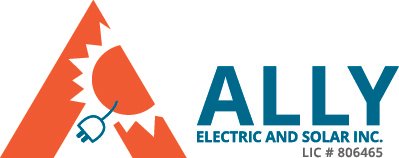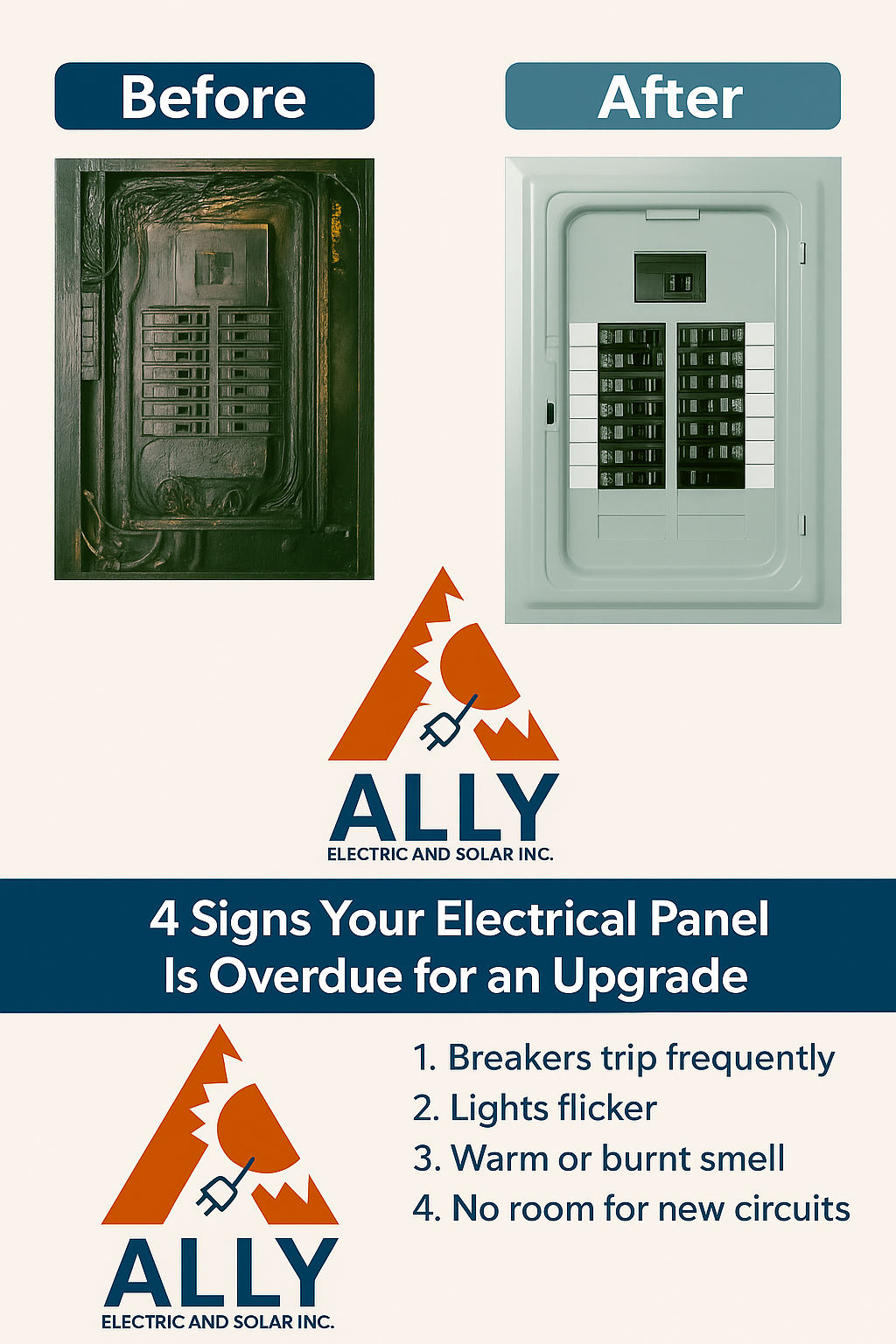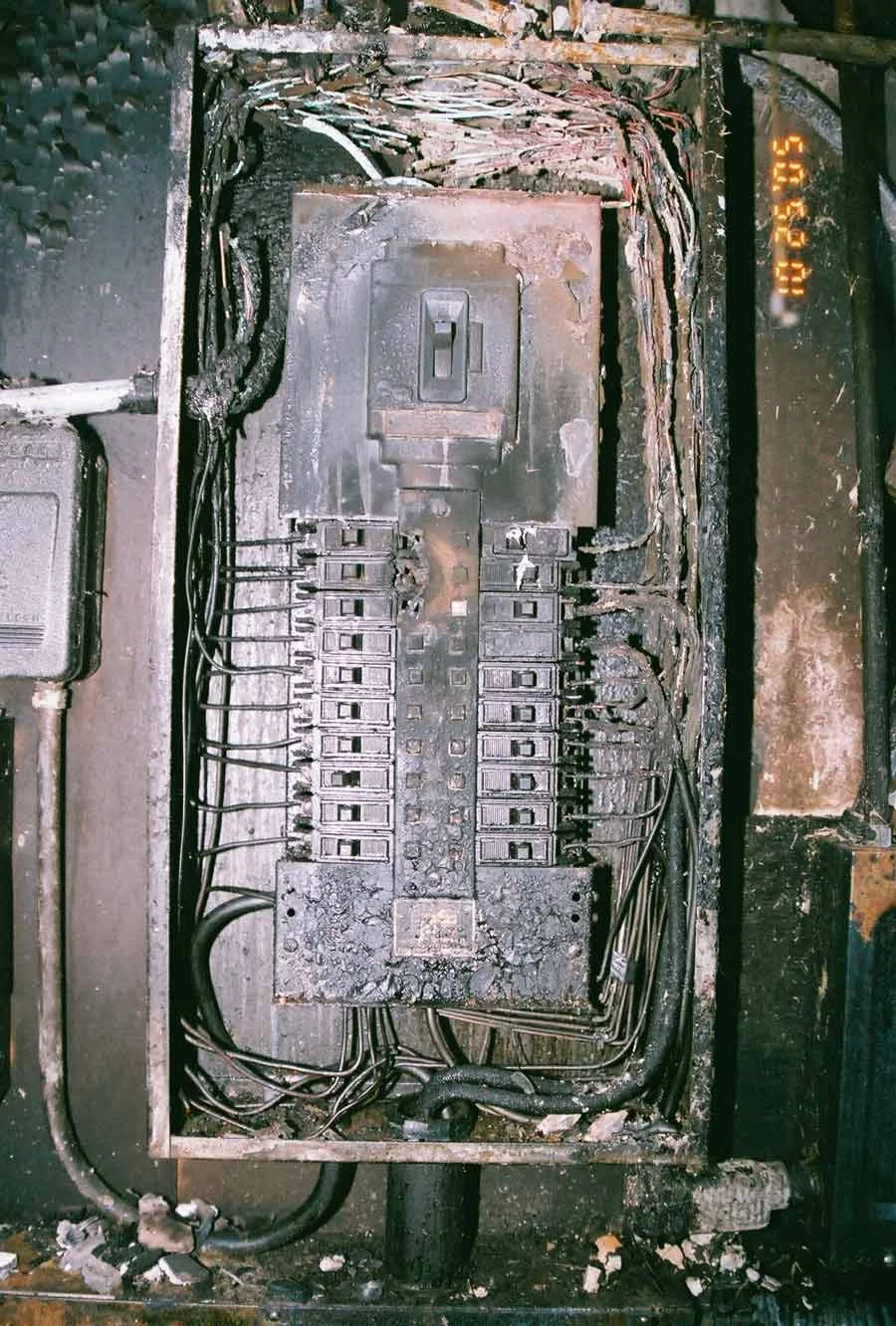10/21/2025
4 Signs Your Electrical Panel Is Overdue for an Upgrade
Your electrical panel is the heart of your home’s power system — quietly distributing electricity to every light, appliance, and outlet. But like any other system, it can wear out or become outdated as your energy needs grow.
Many Bay Area homes still rely on panels installed decades ago — long before today’s high-energy appliances, EV chargers, and solar systems became common. These older systems often show signs of strain long before they fail completely.
Here are four key warning signs that your electrical panel may be due for an upgrade — and how a modern 200-amp panel can make your home safer, more efficient, and ready for the future.
1-Breakers Trip Frequently
If you find yourself constantly resetting tripped breakers, it’s not just an inconvenience — it’s your panel warning you that it’s overloaded.
Each breaker is designed to shut off when the circuit draws more power than it can safely handle. Frequent tripping usually means:
You’ve added new appliances or devices your panel wasn’t designed for.
Breakers or connections inside the panel are worn out.
Your home’s electrical demand exceeds your panel’s total capacity.
Upgrading to a 200-amp service provides the headroom your system needs to handle today’s electrical load safely and efficiently.
2-Lights Flicker or Dim When Appliances Run
If your lights flicker when your refrigerator, air conditioner, or microwave turns on, it’s a red flag that your panel is struggling to balance the load.
Voltage drops like these often indicate:
Loose or corroded connections inside the panel
Undersized wiring or conductors
A system that’s simply maxed out for your household demand
These fluctuations can shorten appliance lifespan and even damage electronics. A modern panel ensures even, stable power throughout your home.
3-Your Panel Feels Warm or Smells Burnt
A healthy electrical panel should never be hot to the touch or emit any burning odor.
Warmth, buzzing, or scorch marks may signal:
Loose breakers creating resistance
Overheating caused by overloaded circuits
Faulty components such as outdated breakers that fail to trip
If you notice any of these warning signs, shut off the main breaker and call a licensed electrician immediately. It’s a potential fire hazard — and a clear sign your panel needs attention or replacement.
4-You’re Out of Breaker Space
Planning to install solar panels, a battery system, an EV charger, or a new HVAC unit? If your breaker box is full, there’s no safe way to add more circuits.
Adding “tandem” breakers or overloading existing slots isn’t a long-term solution — it can create overheating and violate PG&E and city electrical codes.
A new 200-amp main service panel gives you:
Dedicated space for solar, battery, and EV chargers
A clear, organized layout for easier maintenance
Capacity to support future electrical upgrades
In short, a modern panel gives your home the flexibility and safety to grow with your energy needs.
Why Upgrading Now Makes Sense
A main panel upgrade isn’t just about fixing problems — it’s a proactive investment in your home’s safety, reliability, and long-term value.
Benefits include:
Increased fire protection and electrical safety
Stable voltage for sensitive devices
Easier permit approval for future projects
Better resale appeal with modern infrastructure
Trust Ally Electric & Solar for Safe, Code-Compliant Upgrades
At Ally Electric & Solar, our licensed electricians specialize in main panel upgrades that bring your home up to modern electrical standards.
We handle the entire process — from PG&E coordination and permits to final inspection — ensuring your system is safe, efficient, and future-ready.
Whether you’re upgrading for safety, planning to install solar, or preparing for an EV charger, we’re here to help you power your home with confidence.
Schedule Your Free Electrical Panel Inspection Today
Ally Electric & Solar, Inc.
California Licensed Electrical Contractor — License #806465
Serving the Greater San Francisco Bay Area
info@allyelectricandsolar.com
(510) 556-7990
www.allyelectricandsolar.com
Book your free main panel inspection today and find out how we can help you upgrade safely, efficiently, and affordably.
10/13/2025
Do I Need a Main Panel Upgrade Before Installing Solar or an EV Charger?
If you’re thinking about adding solar panels or an electric vehicle (EV) charger to your home, you’ve probably heard that you might also need a main service panel upgrade. Many homeowners are surprised to learn that their existing electrical panel may not have enough capacity to safely handle new equipment — and that upgrading it is often required before getting city or PG&E approval.
Here’s what you need to know about why these upgrades matter, how to tell if you need one, and what the process looks like in the Bay Area.
What Is a Main Service Panel?
Your main electrical panel — often called the breaker box — is where electricity from PG&E enters your home and is distributed to various circuits. It’s the “command center” of your electrical system, housing breakers that protect your wiring and devices from overload.
Older homes (especially those built before the 1990s) often have 100-amp panels, which were fine for that era’s smaller power needs. But modern homes — with solar systems, EV chargers, heat pumps, and high-efficiency HVACs — can easily exceed that capacity.
Why Solar and EV Projects Often Require Panel Upgrades
Both solar energy systems and EV chargers draw (or backfeed) substantial electrical current. That means your panel must safely handle higher amperage and provide extra space for new breakers.
Here’s why inspectors and utilities often require an upgrade:
Solar backfeed limits – PG&E and city electrical codes typically limit solar inverter backfeed to 120% of your panel’s busbar rating. A 100-amp panel with a 100-amp main breaker allows only a small solar system before exceeding this rule.
EV charging load – A Level 2 EV charger draws 40 amps continuously. On a 100-amp service, that can consume nearly half your total capacity.
Safety & overheating risk – If your panel is near its maximum load, adding new devices increases the risk of overheated breakers, nuisance trips, and electrical fires.
Permit and inspection compliance – Building departments will not approve new high-load circuits on undersized or obsolete panels. Upgrading ensures you meet NEC and Title 24 requirements.
In short: installing solar or an EV charger without checking your main panel could lead to permit rejections or unsafe conditions.
How to Tell If You Need a Main Panel Upgrade
Here are a few easy ways to know if your home may require an upgrade before going solar or electric:
Your panel rating is 100 amps or less. Look inside your breaker box — the main breaker should be labeled 100A, 125A, or 200A. Anything below 200A usually needs evaluation.
You have an older panel brand like Federal Pacific, Zinsco, or Pushmatic. These are outdated and often flagged for safety issues.
You’re out of breaker space. If every slot is filled, there’s no room for solar or EV breakers.
Your lights flicker or breakers trip often. That can signal an overloaded or deteriorating panel.
If any of these sound familiar, a licensed electrician can perform a load calculation to determine if a 200-amp upgrade is necessary.
What a Main Panel Upgrade Involves
A main service panel upgrade (MSP) typically includes:
Site inspection and load calculation – to determine required capacity.
Utility coordination – notifying PG&E for a temporary power disconnect/reconnect.
Permit & inspection – handled by your contractor (Ally manages the paperwork).
New 200-amp panel installation – with labeled circuits, surge protection, and room for expansion.
Final inspection and reconnection – ensuring full code compliance.
The process usually takes one day of on-site work and about 2–4 weeks total with permits and utility scheduling.
How Much Does It Cost?
Main panel upgrade’ costs in the Bay Area changes depending on factors like:
Panel size and meter location
Distance from service entrance
Required trenching or conduit upgrades
City permit and inspection fees
While that’s an investment, it’s a one-time upgrade that will serve your home safely for decades — and it’s often necessary to unlock the benefits of solar energy and EV charging. Please contact with us for pricing.
Benefits of Upgrading Before Solar or EV Installation
Pass inspections easily – avoid delays from PG&E or city plan checkers.
Future-proof your home – ready for batteries, heat pumps, or a second EV.
Improve resale value – modern electrical systems are a selling point.
Protect your investment – ensure your new solar or EV charger operates safely and efficiently.
Why Choose Ally Electric & Solar
At Ally Electric & Solar, we specialize in solar-ready main panel upgrades and full permit coordination with PG&E and local cities.
We don’t just swap panels — we make sure your home’s entire electrical system is safe, code-compliant, and ready for the future.
Whether you’re planning solar, installing an EV charger, or just want peace of mind, our licensed electricians can evaluate your setup and recommend the right solution.
Schedule Your Free Panel Inspection Today
Ally Electric & Solar, Inc.
California Licensed Electrical Contractor — License #806465
Serving the Greater San Francisco Bay Area
info@allyelectricandsolar.com
(510) 556-7990
www.allyelectricandsolar.com
10/06/205
100 Amp vs. 200 Amp Electrical Panel: Which One Does Your Home Need?
If your home was built before the 1990s, there’s a good chance it still has a 100-amp electrical panel. While that may have been plenty decades ago, today’s homes use far more electricity — from air conditioning and EV chargers to solar systems and smart appliances. Upgrading to a 200-amp main service panel isn’t just a luxury anymore — it’s often a necessity for safety, convenience, and future energy upgrades.
Let’s explore the difference between 100-amp and 200-amp panels, how to know what you have, and when it’s time for an upgrade.
What Does an Electrical Panel Do?
Your main service panel — often called the breaker box — is the control center of your home’s electrical system. It distributes incoming power from the utility to all the circuits in your home and provides circuit protection through breakers that shut off when overloaded.
Think of it as your home’s electrical “traffic controller.” When the panel is outdated or undersized, it can’t safely handle today’s higher energy demands.
100 Amp vs. 200 Amp Panels: The Key Differences
Feature100 Amp Panel200 Amp PanelTypical Installation YearBefore 1990s1990s to presentElectrical CapacityUp to ~12 kWUp to ~24 kWSuitable ForSmaller homes, minimal appliancesModern homes, solar, EVs, HVACCommon IssuesOverloaded circuits, tripped breakersAmple capacity for future growthSafety MarginLimitedHigh — supports expansion safely
A 200-amp panel doubles the available electrical capacity compared to a 100-amp one. That means less risk of overheating, fewer tripped breakers, and room to grow as your energy needs evolve.
Signs You Might Need a Panel Upgrade
You don’t need to be an electrician to spot the warning signs. You may need a main panel upgrade if you notice any of the following:
Lights flicker or dim when appliances start
Breakers trip often
Panel feels warm to the touch
You rely on extension cords or power strips
You’re planning to add:
Solar panels or battery storage
An EV charger (Level 2 or higher)
A new HVAC system or heat pump
A kitchen or room addition
If any of these apply, your current panel may be operating near (or above) its safe limit.
Why a 200 Amp Panel Is the New Standard
Electrical demands in California homes have nearly doubled in the past 25 years. The shift toward electrification — EVs, solar, heat pumps, induction cooking — is pushing the limits of older systems.
Upgrading to 200 amps provides:
Room for future expansion (solar, battery, EV, HVAC)
Improved safety — reduced overheating and fire risk
Insurance and resale advantages — inspectors and buyers prefer modern panels
Code compliance — many jurisdictions now require 200A for new projects
In short, a 200-amp upgrade makes your home “future-ready.”
How Much Does a Main Panel Upgrade Cost?
Every home is unique, but typical main panel upgrades in the Bay Area range from $2,000 to $4,000, depending on:
Service size and wiring condition
Meter location and accessibility
Permit and utility coordination (PG&E, City)
Optional upgrades for solar readiness or battery interconnection
At Ally Electric & Solar, we handle the entire process — permits, PG&E coordination, and installation — so you get a seamless, code-compliant result.
Solar, Battery, or EV Charger Coming Soon?
If you plan to install a solar system, battery backup, or electric vehicle charger, a main panel upgrade is often required before those systems can be interconnected.
PG&E and most city inspectors will not approve new energy systems on undersized or outdated panels.
That’s why we always recommend scheduling a free electrical inspection before you begin your solar or EV project.
Future-Proof Your Home Today
Upgrading your main electrical panel may not be as exciting as adding solar panels or a Tesla charger — but it’s the foundation that makes everything else possible.
With a 200-amp upgrade, your home becomes safer, smarter, and ready for the clean-energy future.
Ready to Upgrade? Contact Ally Electric & Solar
Ally Electric & Solar, Inc.
California Licensed Electrical Contractor — License #806465
Serving the Greater San Francisco Bay Area
info@allyelectricandsolar.com
(510) 556-7990
www.allyelectricandsolar.com
Schedule your free main panel inspection today — and let our licensed electricians help you bring your home safely into the modern age.
07/24/2025
Why Federal Pacific & Zinsco Panels Are Failing Modern Homes
If your home still has a Federal Pacific Electric (FPE/Stab-Lok) or Zinsco electrical panel, you may be living with a hidden hazard. These outdated panels were popular in the 1950s–1980s, but today they are known for serious safety issues, insurance concerns, and compliance problems. If you’re considering adding solar panels or a home battery system, replacing these panels isn’t just recommended — it’s often required.
What’s Wrong With Zinsco and Federal Pacific Panels?
Fire Hazard – Independent testing has shown that many breakers in FPE and Zinsco panels fail to trip when they should. That means if your system is overloaded, instead of shutting off, the wires can overheat — a leading cause of electrical fires.
Outdated Technology – These panels were never designed for today’s electricity demands. Modern homes run high-powered HVAC, appliances, EV chargers, and (increasingly) solar and battery systems. An old panel simply can’t handle the load safely.
Insurance & Real Estate Issues – Many insurance companies refuse coverage for homes with these panels. Likewise, buyers and home inspectors often flag them as a major issue during real estate transactions.
Why a Main Panel Upgrade Is Required Before Solar & Batteries
If you’re interested in solar panels or energy storage (battery backup), the first step is making sure your electrical system can safely handle the new equipment. Utilities and inspectors generally will not approve solar or battery interconnections with a Federal Pacific or Zinsco panel because:
They can’t safely accept the backfeed power from solar.
They may not have enough amperage to support a new system.
Code requirements (NEC and local AHJ rules) prohibit unsafe equipment.
That means upgrading your main service panel isn’t optional — it’s mandatory if you want to move forward with solar or battery installation.
Benefits of Upgrading Your Panel
Safety First – Reduce the risk of electrical fire and protect your family.
Peace of Mind – Avoid insurance coverage problems.
Future-Ready – Be prepared for solar panels, a home battery, or even EV charging when you’re ready.
Increased Home Value – Modern electrical infrastructure adds value to your property.
Next Steps for Homeowners
If your home has a Federal Pacific (FPE/Stab-Lok) or Zinsco panel, now is the time to take action. At Ally Electric & Solar, we specialize in safe and code-compliant main panel upgrades that make your home solar-ready.
Schedule a free panel inspection today and learn how we can upgrade your home’s electrical system and prepare you for solar and battery savings.
Contact Ally Electric & Solar
Ally Electric & Solar, Inc.
California Licensed Electrical Contractor — License #806465
Serving the Greater San Francisco Bay Area
info@allyelectricandsolar.com
(510) 556-7990
www.allyelectricandsolar.com



